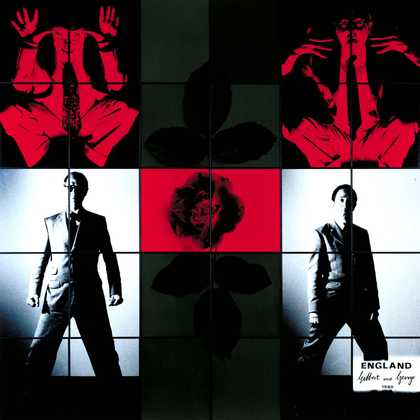
Gilbert & George, England 1980. Tate. ôˋ Gilbert and George.
No Such Thing as Society 1980ã1990
14 rooms in Modern and Contemporary British Art
Against a backdrop of economic and social transformation, artists in the 1980s explore their experience of the land and the body to reflect on their own identities and sense of belonging
Margaret Thatcherãs premiership spans and defines much of Britain in this decade. Her government cuts public spending, privatises nationalised industries and challenges the power of unions. In 1984, the National Union of Mineworkers holds a year-long strike. By 1986, over three million people are unemployed. Meanwhile, after the ãBig Bangã of financial deregulation, the wealth of the City of Londonãs financial sector increases. The Northern Ireland conflict, known as the Troubles, continues. Young Black people across England clash with law enforcement against racial discrimination and police brutality. In 1986, as the AIDS epidemic rips through LGBTQIA+ communities, the British government prohibits local authorities from promoting, LGBTQIA+ rights.
Many of the artists in this room make work reflecting on life in Britain. Artists reframe their familiar ideas to express a combination of hope and frustration. Britain is viewed from the North of England, suburban gardens, the streets of Brixton in South London, and the Maze Prison in Northern Ireland. Other artists focus on the body to explore the boundaries between private and public social space. Some reflect on the experience of illness and death. Others make work about gender identity, sexuality or racial violence, using their personal experiences of being othered or excluded.
Tish Murtha, Alleyway, Kenilworth Road from the series ãJuvenile Jazz Bandsã 1979
This black and white photograph is from Tish Murthaãs series Juvenile Jazz Bands 1979. Murtha studied documentary photography in Newport, Wales, where she was taught by photographer David Hurn (born 1934), a member of the international photography cooperative Magnum Photos. She returned to the Newcastle area in 1978, capturing the impact of deindustrialisation, as well as the social and economic disadvantages of those living in her area, disadvantages which she had also experienced.
1/30
artworks in No Such Thing as Society
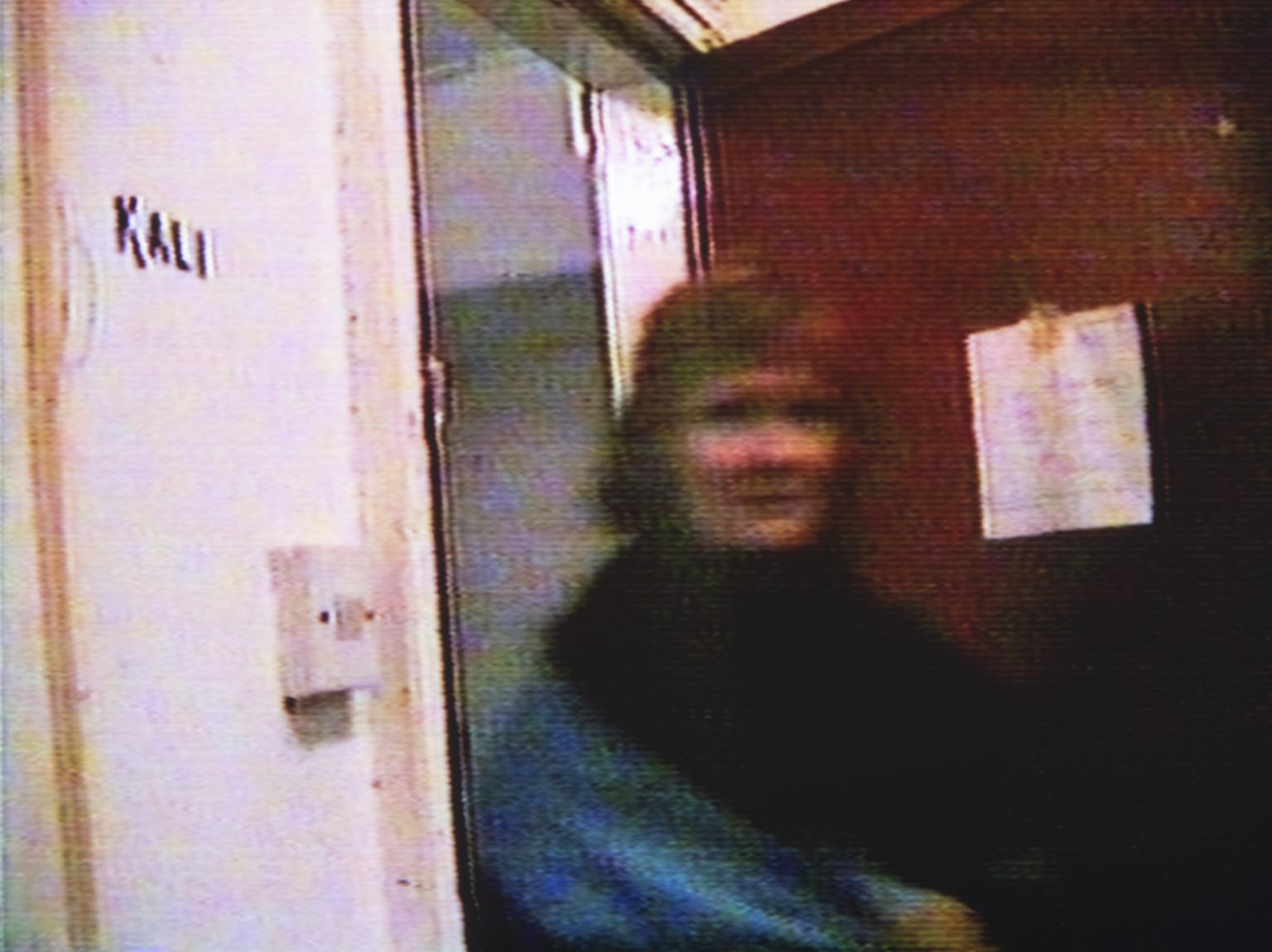
Sutapa Biswas, Kali &ýåýºý¾ÝÒ;1983ã1985
Kali documents a performance Biswas staged with Isabella Tracy. The artists play themselves and the characters Kali and Ravan from Hindu mythology. The film opens with an introduction from Biswas explaining that the characters of the performance enact a mythic struggle of good over evil. Kali represents a challenge to forces of ãimperialism, cultural domination and exploitation of the East by the Westã. As part of the performance, art historian Griselda Pollock sits on a chair wearing a hood. As a student, Biswas challenged Pollock for not engaging meaningfully with issues of race and colonialism while making space for discussion of gender and class. This exchange led Pollock to radically revise the Leeds University art history syllabus. Biswas notes, ãI arrived and said: ãYouãve got to change the course.ã I was lucky because she listenedã.
Gallery label, November 2023
2/30
artworks in No Such Thing as Society
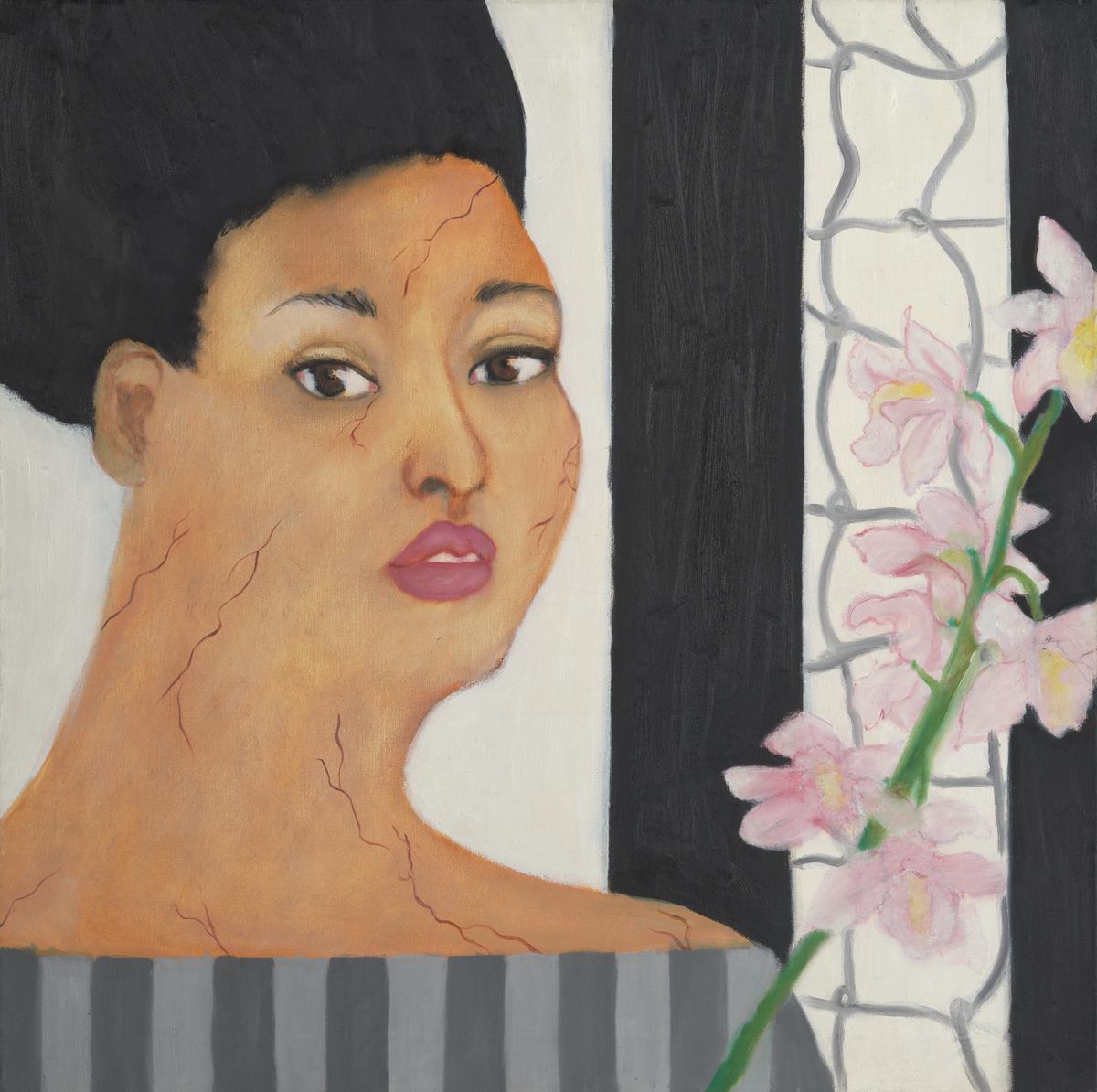
Rita Keegan, Homage to Frida Kahlo 1987
In this self-portrait, Rita Keegan stares out at the viewer. Her direct gaze recalls the self-portraits of Mexican painter Frida Kahlo (1907ã1954). Cracks appear throughout her face, neck and chest. Portraiture and self-portraiture feature regularly in Keeganãs practice and are often references to her family photographs. Her extensive archive documents her Black middle-class Canadian family from the 1890s to the present day. Keegan moved to London in 1980 from the US and, in 1982, co-founded Brixton Art Gallery. She has spent her career working to support artists of colour.
Gallery label, January 2025
3/30
artworks in No Such Thing as Society
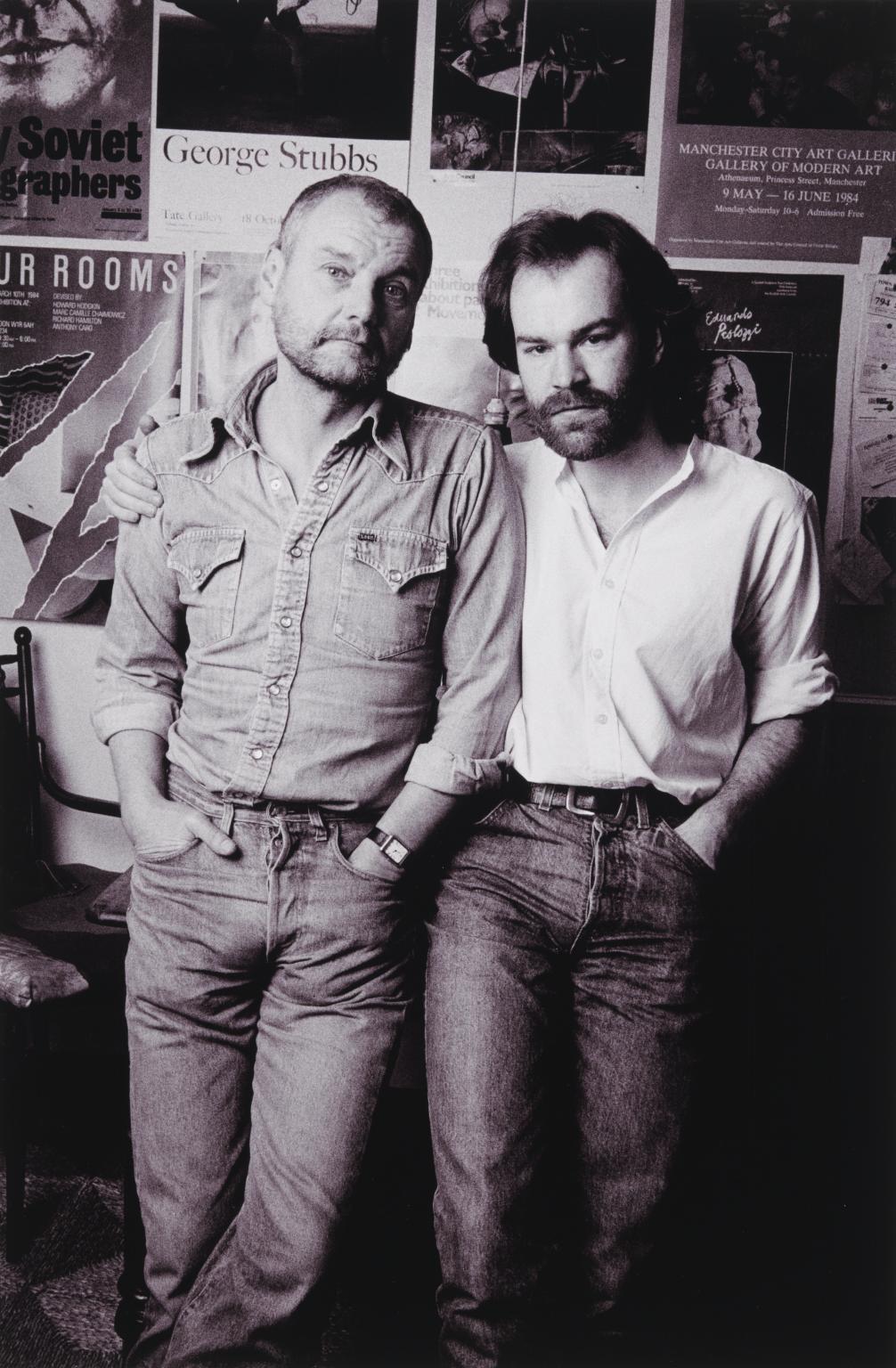
Sunil Gupta, Emmanuel & David, London 1984, printed 2018
This series of black and white portraits features gay and lesbian couples from Sunil Guptaãs social circles in London and Newcastle. Called Lovers: Ten Years On, the project was shot over a period of two years from 1984ã6, following the end of Guptaãs own ten-year relationship. Reminiscent of traditional family portraits, the photographs show couples in affectionate poses in their own living spaces. Prejudicial coverage of the HIV and AIDS epidemic in the 1980s threatened to turn public opinion against the acceptance of queer relationships, which were portrayed as ãsexually deviantã. In contrast to these offensive depictions of queer love, the people in Lovers: Ten Years On are often presented as quite ordinary, middle-class, professional couples. Many of the people photographed would later lose their lives to HIV and AIDS.
Gallery label, January 2025
4/30
artworks in No Such Thing as Society
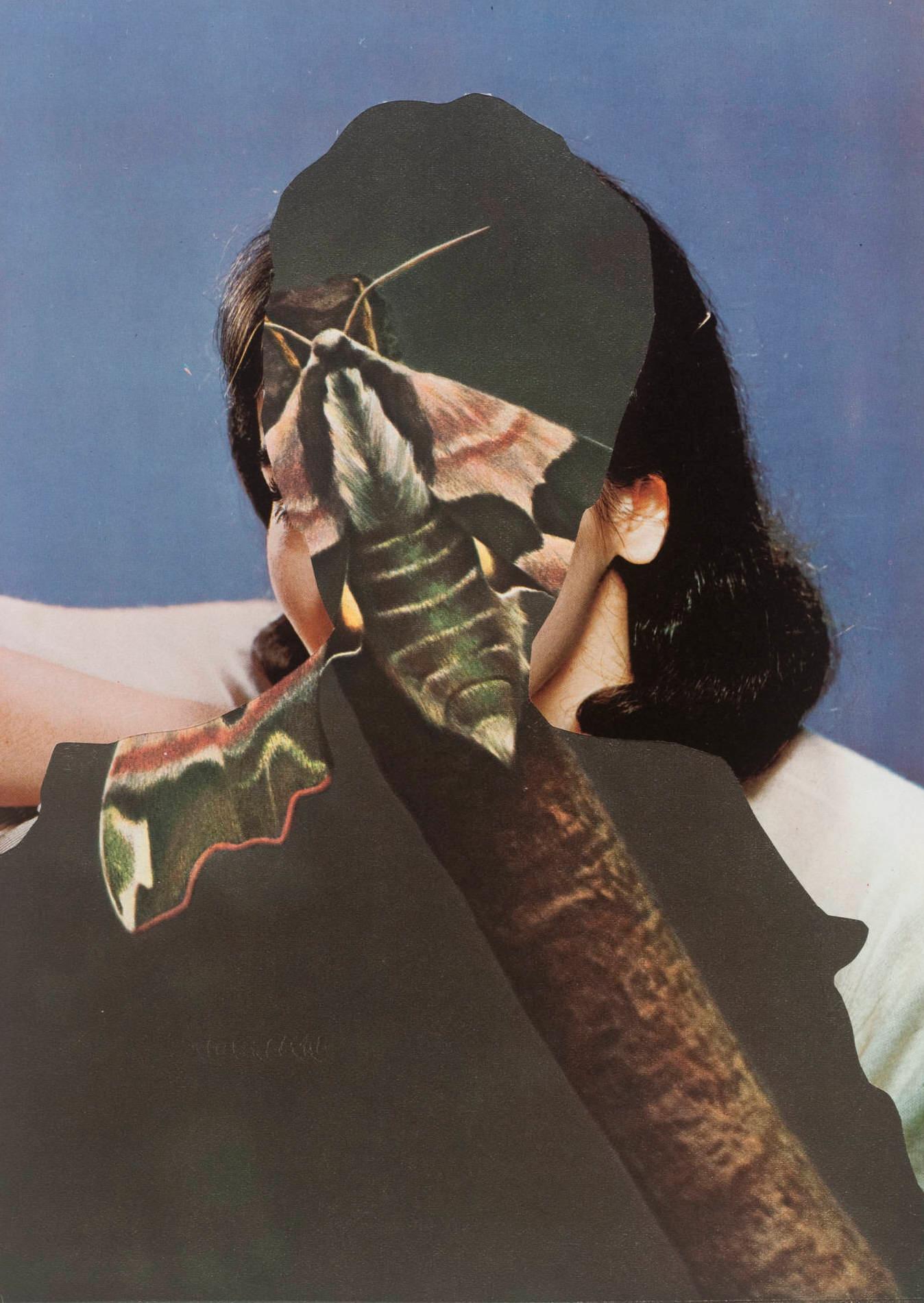
John Stezaker, Untitled 1989
Untitled is a collage combining three separate images. The principal image is a colour photograph of a film actress taken in the 1940s or 1950s. Her face has been excised by the silhouetted figure of another woman cut out of the paper on which the portrait was printed. The space of the silhouette is filled with a photographic reproduction of a moth on a branch. As is usual in a portrait, the photographed actress looks at the viewer but as a result of the artistãs intervention only her cheek, a few eyelashes and a sliver of eyebrow are visible on her right side and her jaw and ear on her left. Her right shoulder and part of her forearm are raised ã she appears to be leaning on something. Stezakerãs collage obscures all the parts of her normally needed to read a portrait and in this sense the silhouetted figure operates like a mask ã a concept central to Stezakerãs work (see Masks XI, XIII and XIV, 2005-6, T12345-7). The artist derived the image of the moth from an early colour photogravure, printed in a volume of The Natural World (a pre-war publication Stezaker found in a second hand book shop). The colours of its unusual markings ã a delicate pink, white and two shades of brown ã echo what we can see of the film actressãs skin tones, dark brown hair and white blouse or dress. The mothãs patterning covers most of the actressãs face with the uncanny effect of evoking a strange disfigurement. The artist has commented that the image reminds him ãof that combination of the insectile and Victorian interiors in A.S.Byattãs Morpho Eugenia (a short story printed in Angels and Insects, London 1992)ã (letter to the author 27 October 2007).
5/30
artworks in No Such Thing as Society
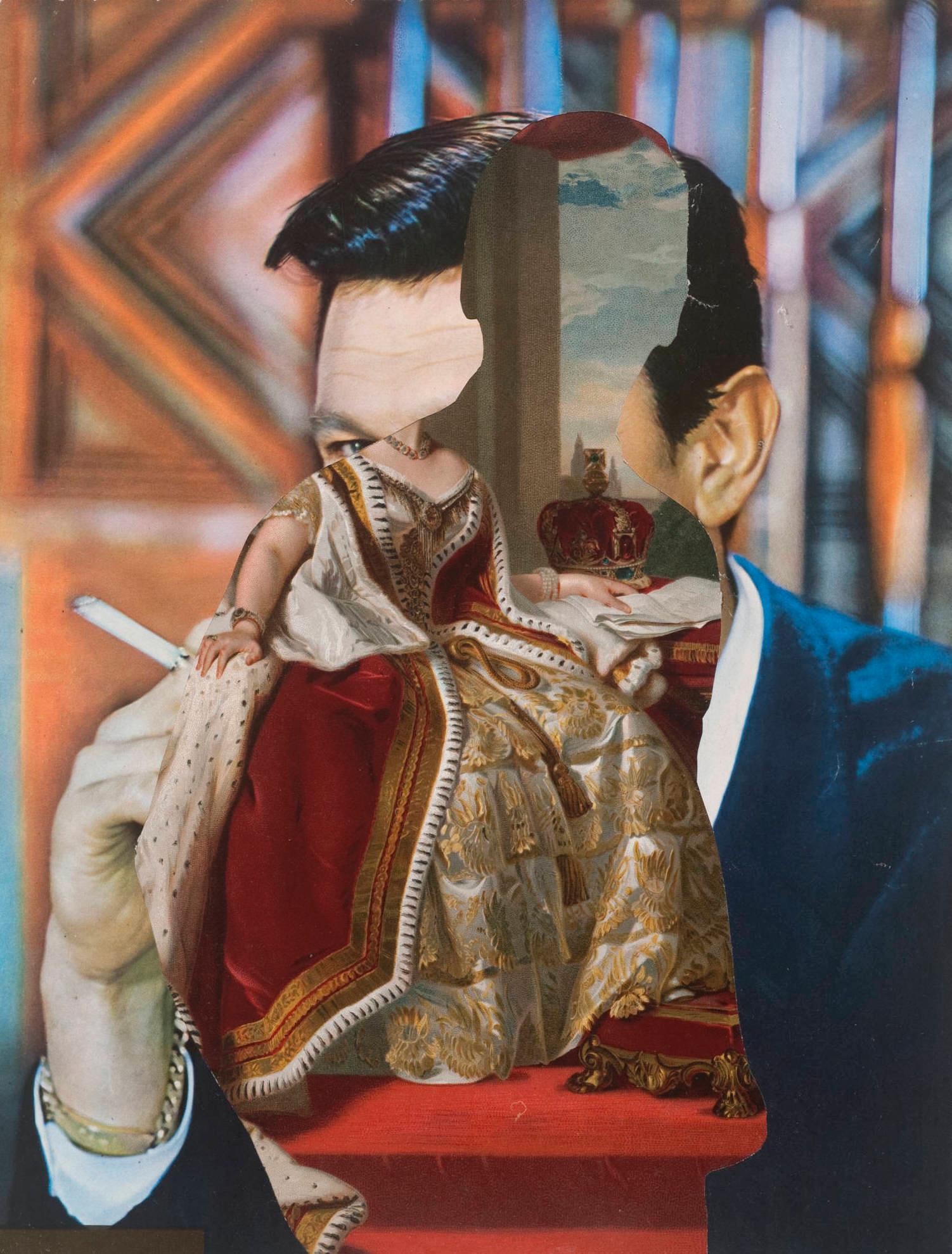
John Stezaker, Third Person &ýåýºý¾ÝÒ;1988ã9
Third Person is a collage combining three separate images. The principal image is a colour photograph of a film actor from the 1940s or 1950s. The silhouetted figure of another man has been cut out of this portrait, eliminating most of the actorãs face and chest, and the space has been filled with a reproduction of a painting of Queen Victoria. The outline of the second man cuts across the actorãs forehead and the corner of his right eye which looks out of the image at the viewer. His right hand, raised close to his face, is bisected by the collaged addition; it holds a cigarette that emerges from the point where the actorãs fingers meet the hand of Queen Victoria, lying on her ermine robes. The outline of the silhouetted male figure cuts off her head at the neck; the line of her necklace extends the line of the smoking actorãs right eyebrow. The silhouetted figureãs head is half filled with the image of a rich blue sky in which clouds are warmly illuminated in orange shades that complement the queenãs skin tones and the flesh tones of the smoking actor. The blue sky echoes highlights of blue light in the smoking actorãs black hair and on his dark jacket. These complimentary colours ã shades of orange and electric blue ã are repeated in the out of focus orange and blue patterning on the wall behind the actor.
6/30
artworks in No Such Thing as Society
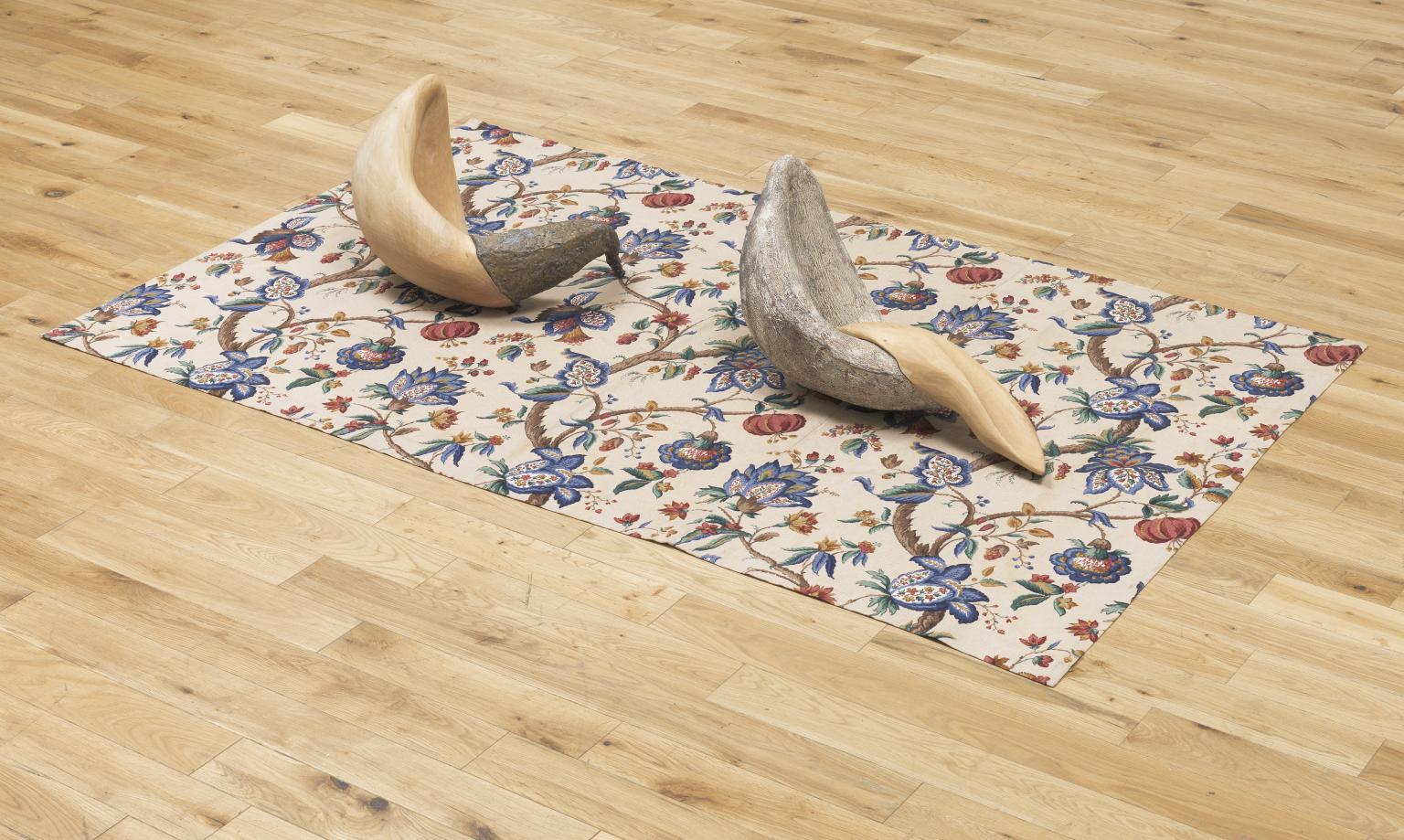
Jacqui Poncelet, Clay, bronze, wood and fabric 1988
Clay, bronze, wood and fabric 1988 is a sculpture that comprises three parts: two objects made of clay, bronze and wood are placed on a rectangular piece of floral fabric laid on the floor. The work has a simple descriptive title which draws attention to its material composition and the contrasts inherent within the combination of the materials used. The two objects have an insistently organic, even visceral, presence. Made using the most traditional of sculptural processes, carving and casting, their sensual lines are suggestive of soft flesh and intimate body parts. The sculpture embodies what the photographer David Ward, writing about Ponceletãs work, has described as a ãfrank and imprudent sexuality in the confluence of form, material, and importantly surface patternã (David Ward, quoted in Irish Museum of Modern Art 1997, p.50).
7/30
artworks in No Such Thing as Society
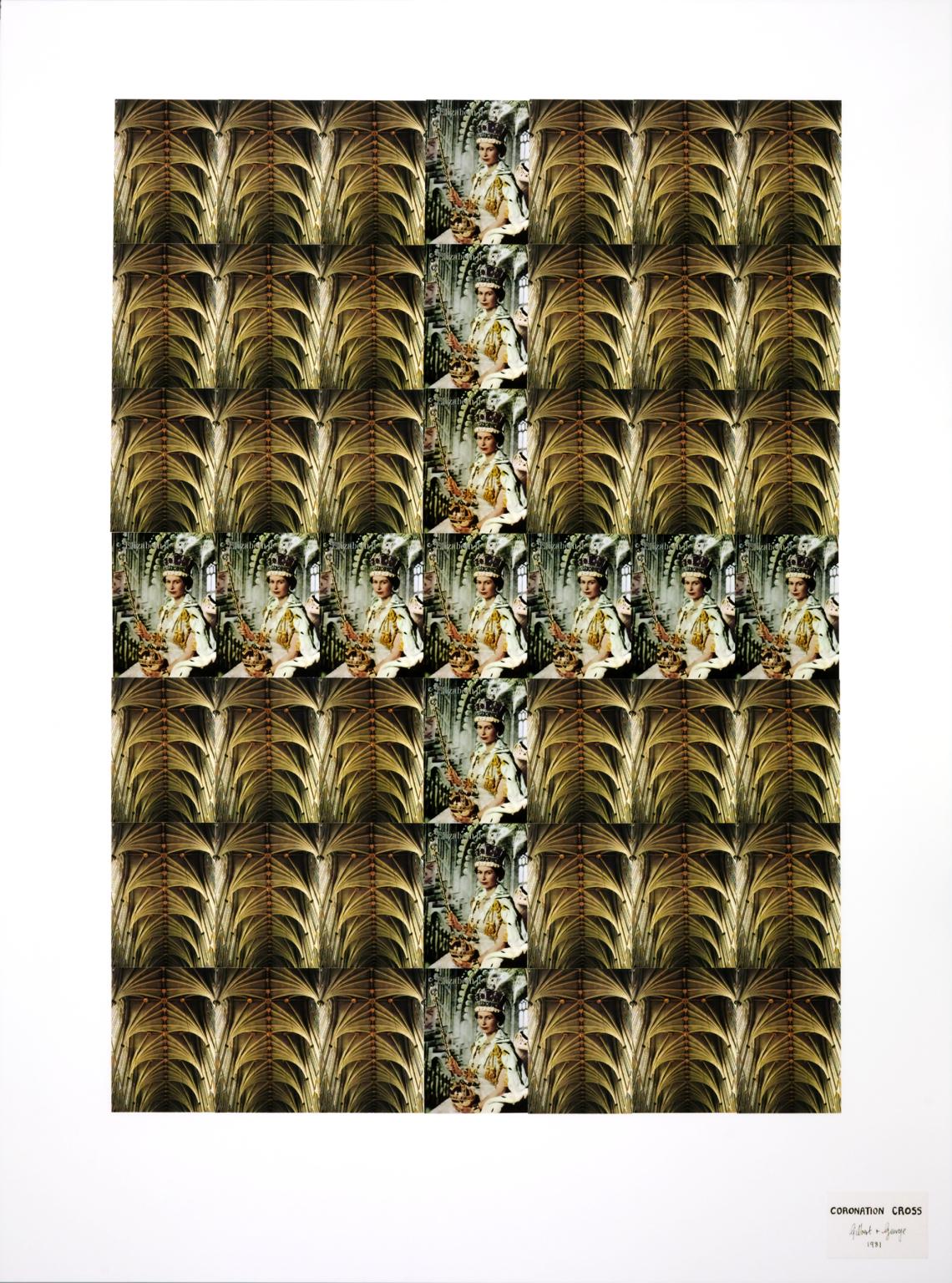
Gilbert & George, Coronation Cross 1981
8/30
artworks in No Such Thing as Society
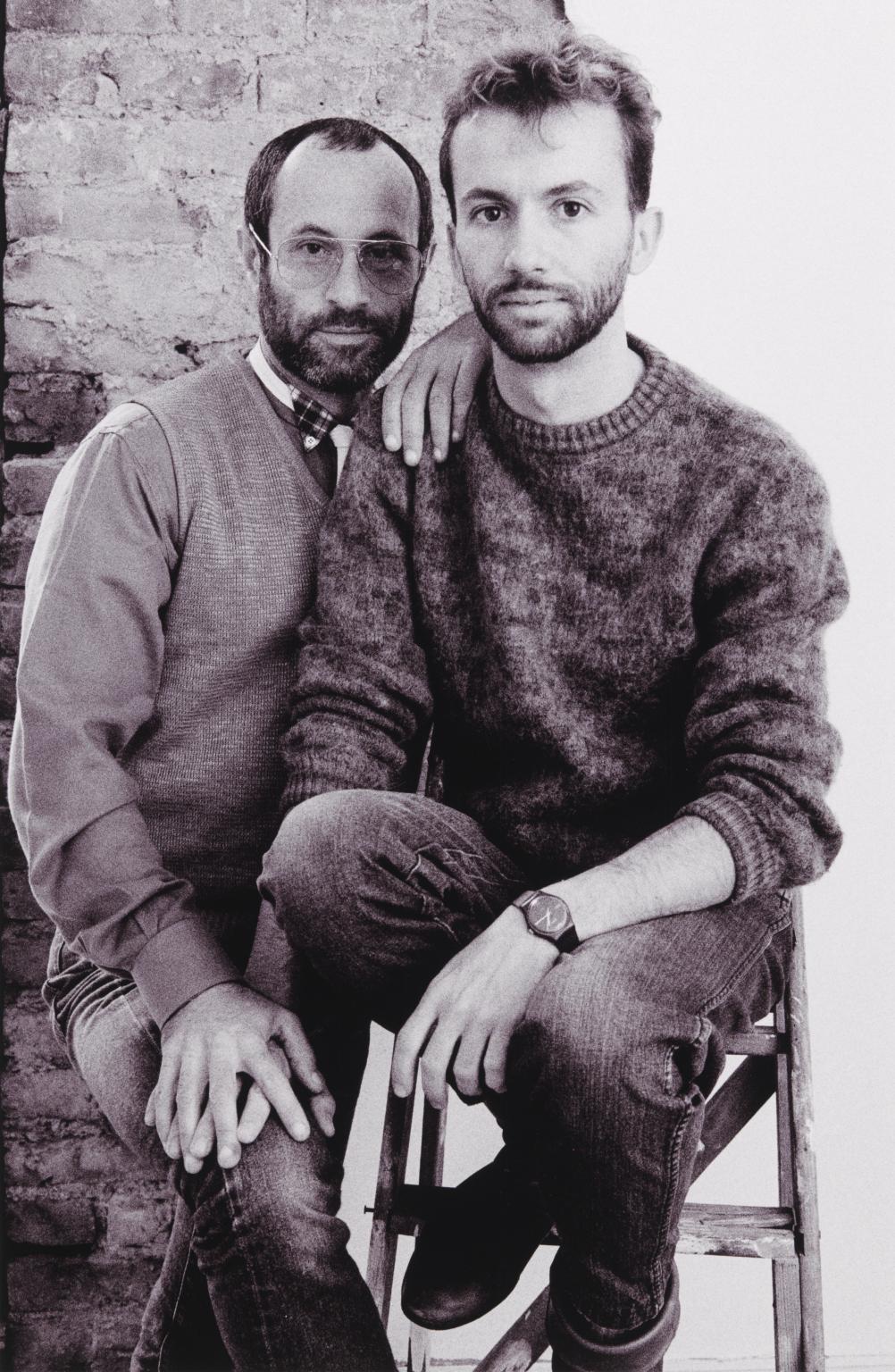
Sunil Gupta, Bruno & Daniel, London 1984, printed 2018
This series of black and white portraits features gay and lesbian couples from Sunil Guptaãs social circles in London and Newcastle. Called Lovers: Ten Years On, the project was shot over a period of two years from 1984ã6, following the end of Guptaãs own ten-year relationship. Reminiscent of traditional family portraits, the photographs show couples in affectionate poses in their own living spaces. Prejudicial coverage of the HIV and AIDS epidemic in the 1980s threatened to turn public opinion against the acceptance of queer relationships, which were portrayed as ãsexually deviantã. In contrast to these offensive depictions of queer love, the people in Lovers: Ten Years On are often presented as quite ordinary, middle-class, professional couples. Many of the people photographed would later lose their lives to HIV and AIDS.
Gallery label, January 2025
9/30
artworks in No Such Thing as Society
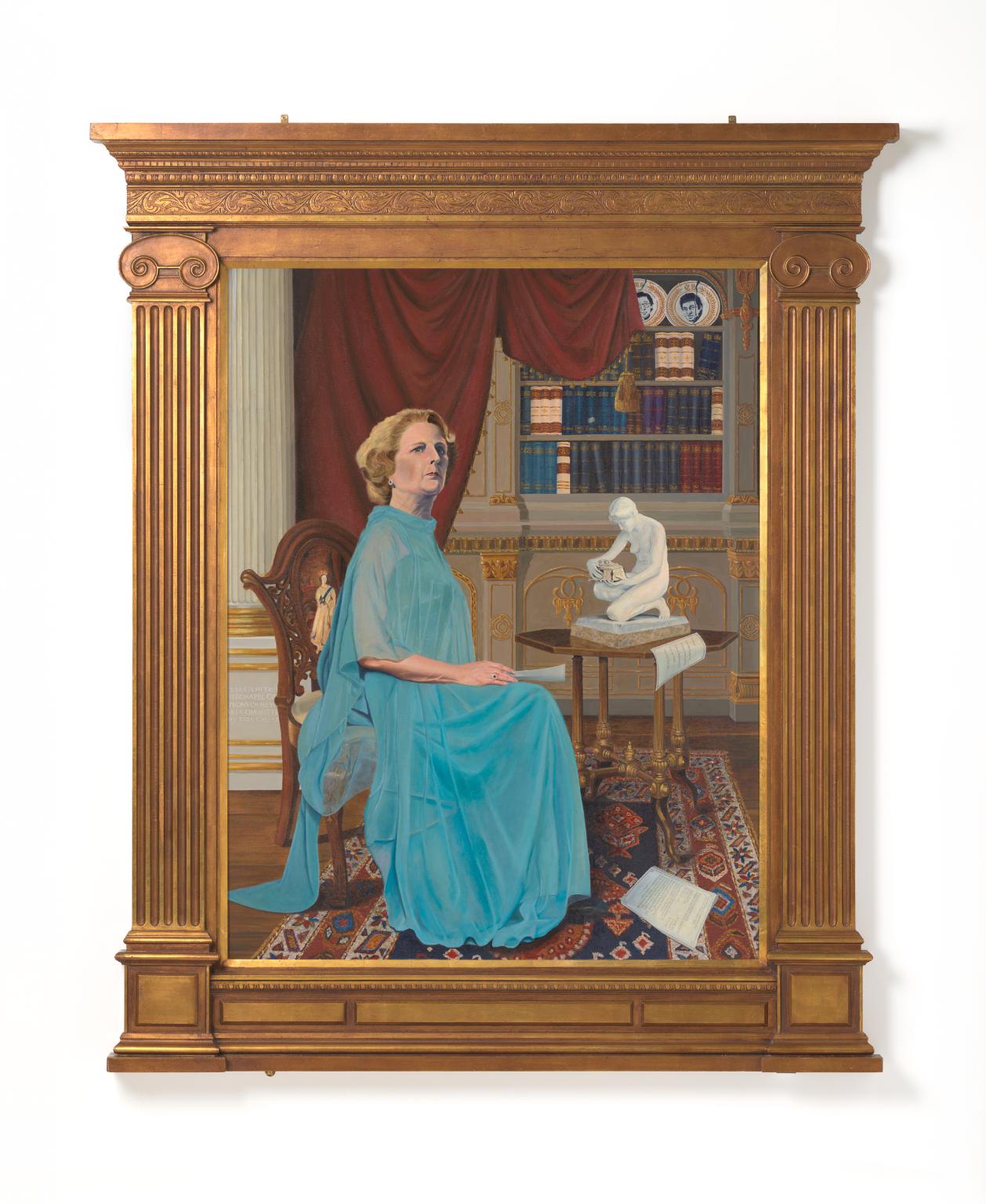
Hans Haacke, Taking Stock (unfinished) &ýåýºý¾ÝÒ;1983ã4
10/30
artworks in No Such Thing as Society
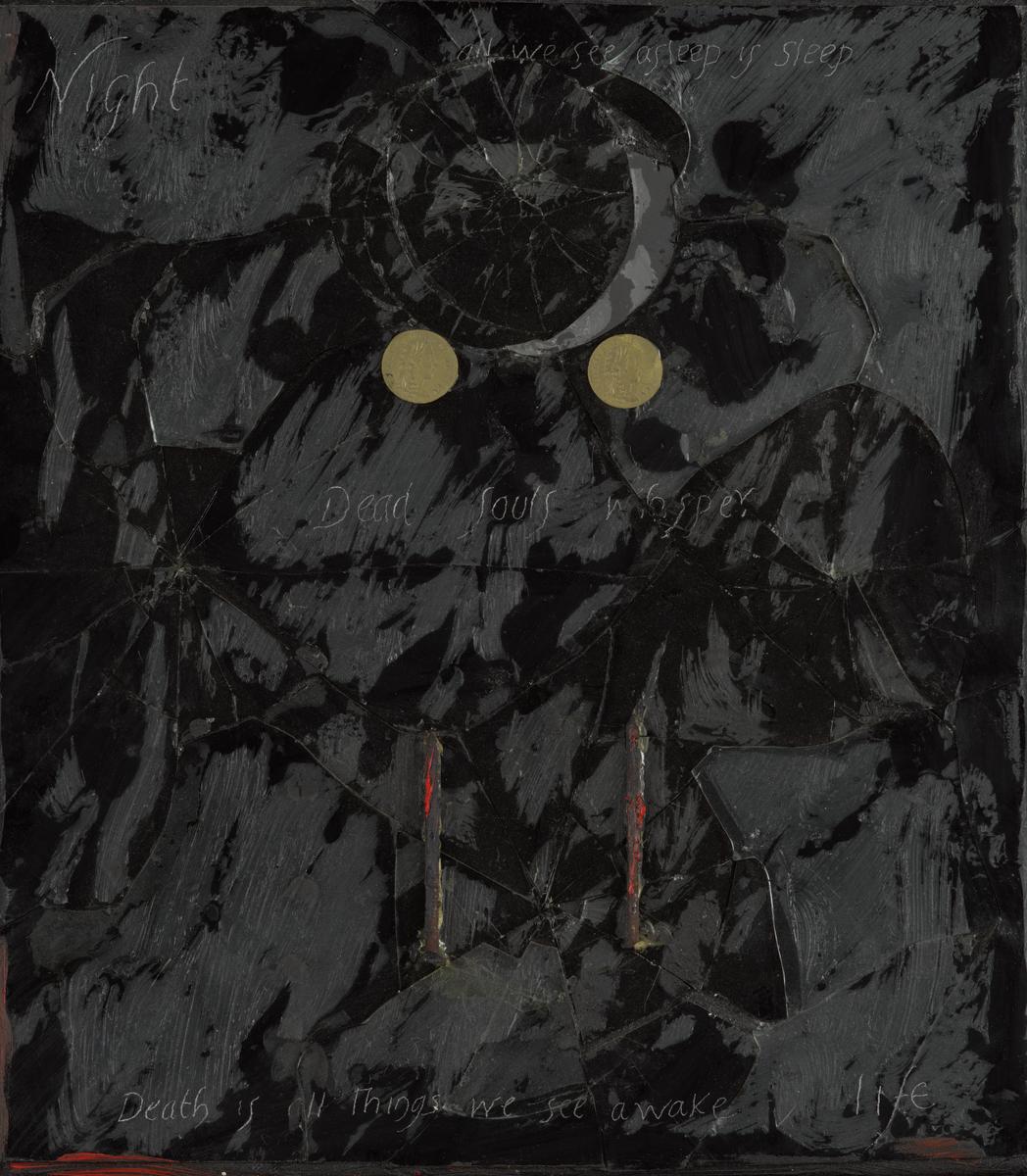
Derek Jarman, Dead Manãs Eyes 1987
11/30
artworks in No Such Thing as Society
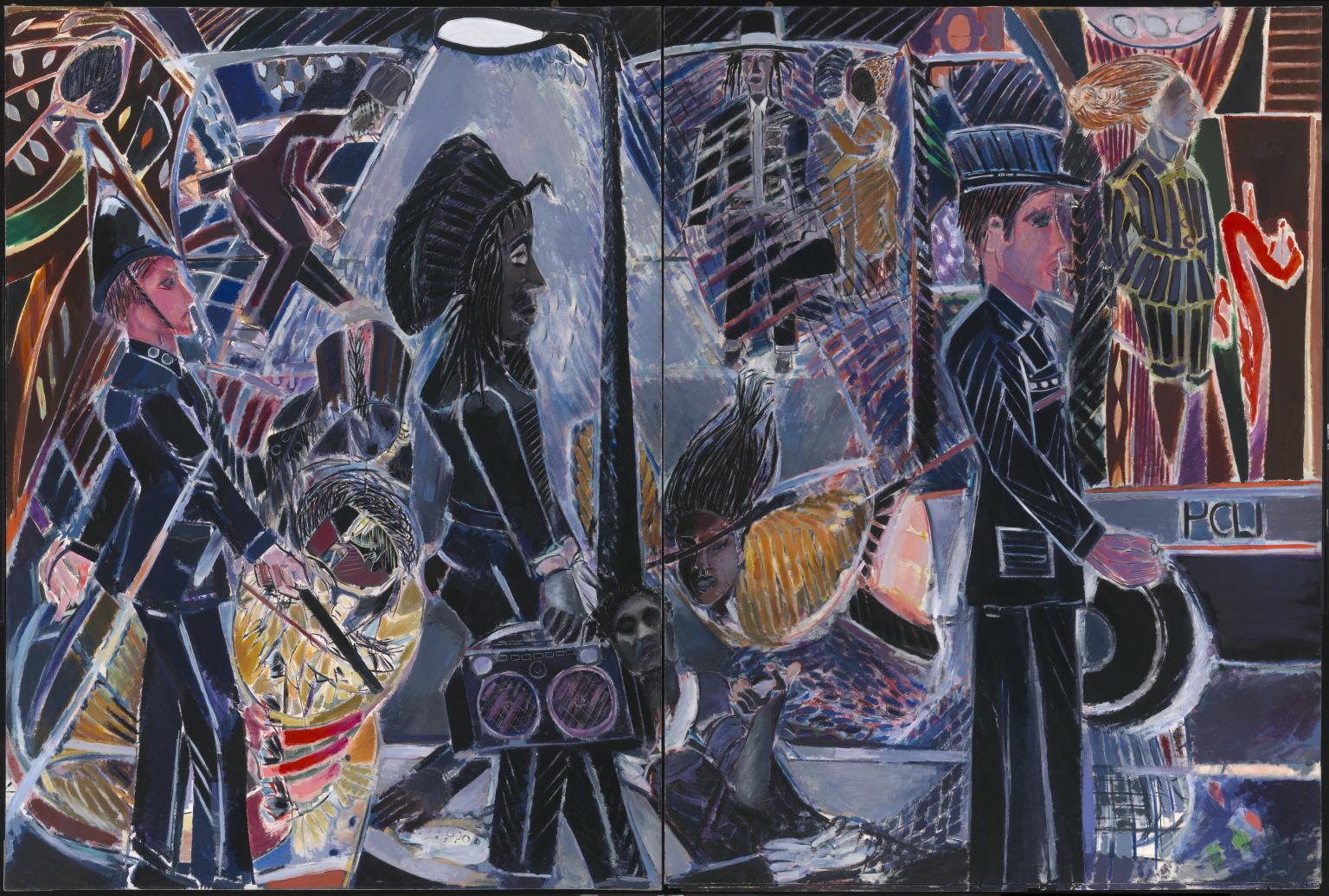
Denzil Forrester MBE, Three Wicked Men 1982
12/30
artworks in No Such Thing as Society
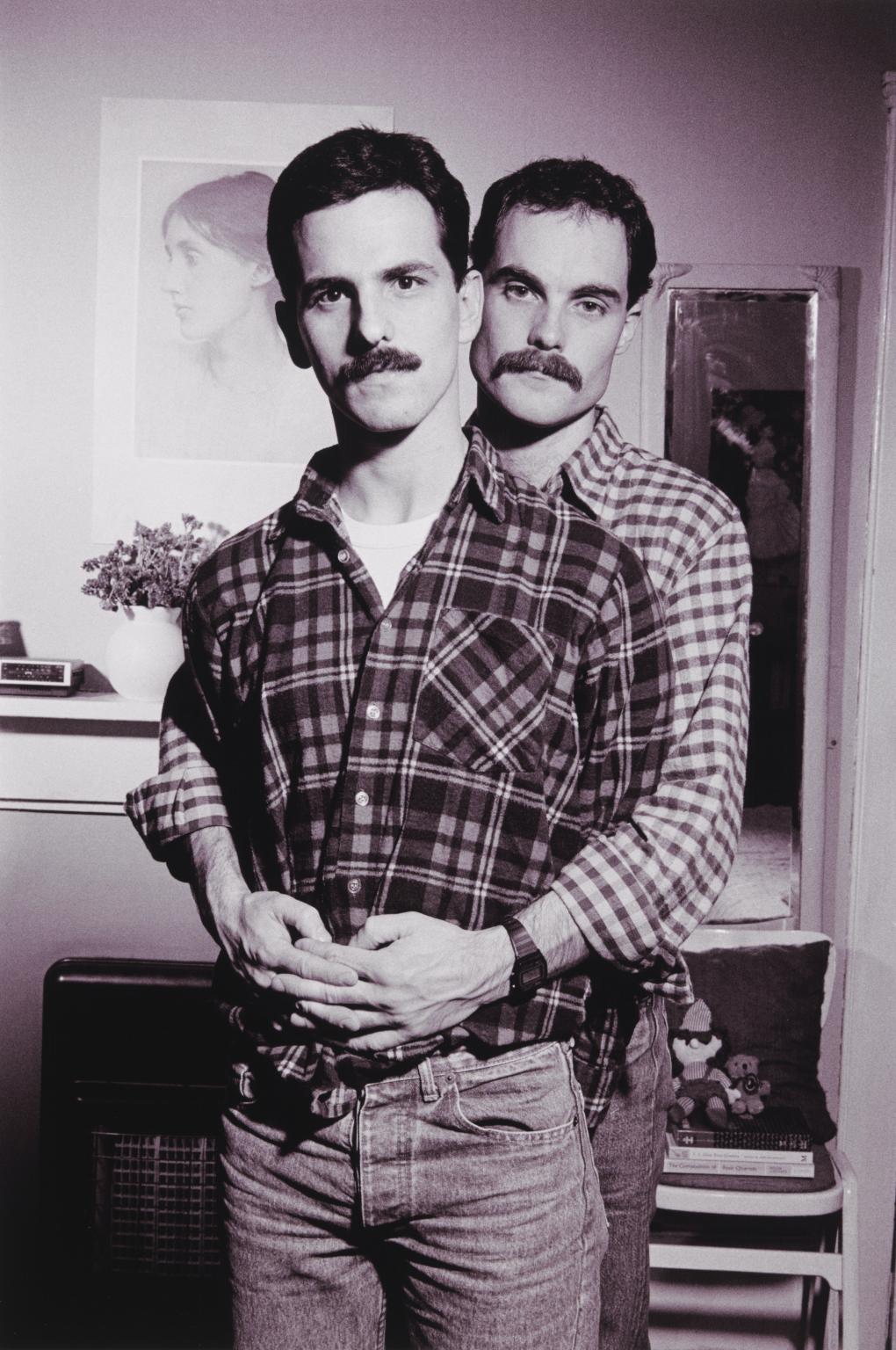
Sunil Gupta, Johnathan & Kim, London 1985, printed 2018
This series of black and white portraits features gay and lesbian couples from Sunil Guptaãs social circles in London and Newcastle. Called Lovers: Ten Years On, the project was shot over a period of two years from 1984ã6, following the end of Guptaãs own ten-year relationship. Reminiscent of traditional family portraits, the photographs show couples in affectionate poses in their own living spaces. Prejudicial coverage of the HIV and AIDS epidemic in the 1980s threatened to turn public opinion against the acceptance of queer relationships, which were portrayed as ãsexually deviantã. In contrast to these offensive depictions of queer love, the people in Lovers: Ten Years On are often presented as quite ordinary, middle-class, professional couples. Many of the people photographed would later lose their lives to HIV and AIDS.
Gallery label, January 2025
13/30
artworks in No Such Thing as Society
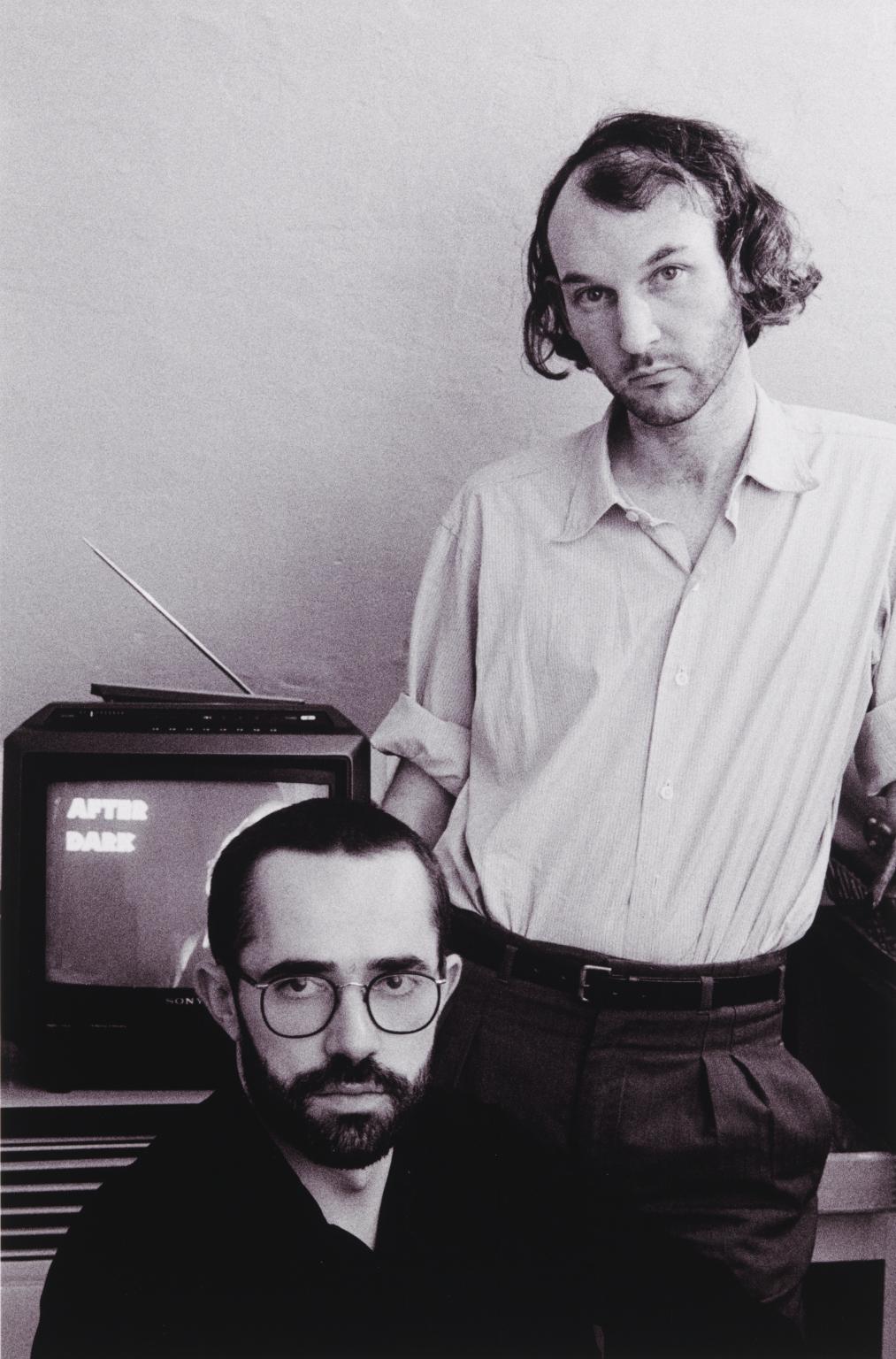
Sunil Gupta, Guy & Brian, London 1984, printed 2018
This series of black and white portraits features gay and lesbian couples from Sunil Guptaãs social circles in London and Newcastle. Called Lovers: Ten Years On, the project was shot over a period of two years from 1984ã6, following the end of Guptaãs own ten-year relationship. Reminiscent of traditional family portraits, the photographs show couples in affectionate poses in their own living spaces. Prejudicial coverage of the HIV and AIDS epidemic in the 1980s threatened to turn public opinion against the acceptance of queer relationships, which were portrayed as ãsexually deviantã. In contrast to these offensive depictions of queer love, the people in Lovers: Ten Years On are often presented as quite ordinary, middle-class, professional couples. Many of the people photographed would later lose their lives to HIV and AIDS.
Gallery label, January 2025
14/30
artworks in No Such Thing as Society
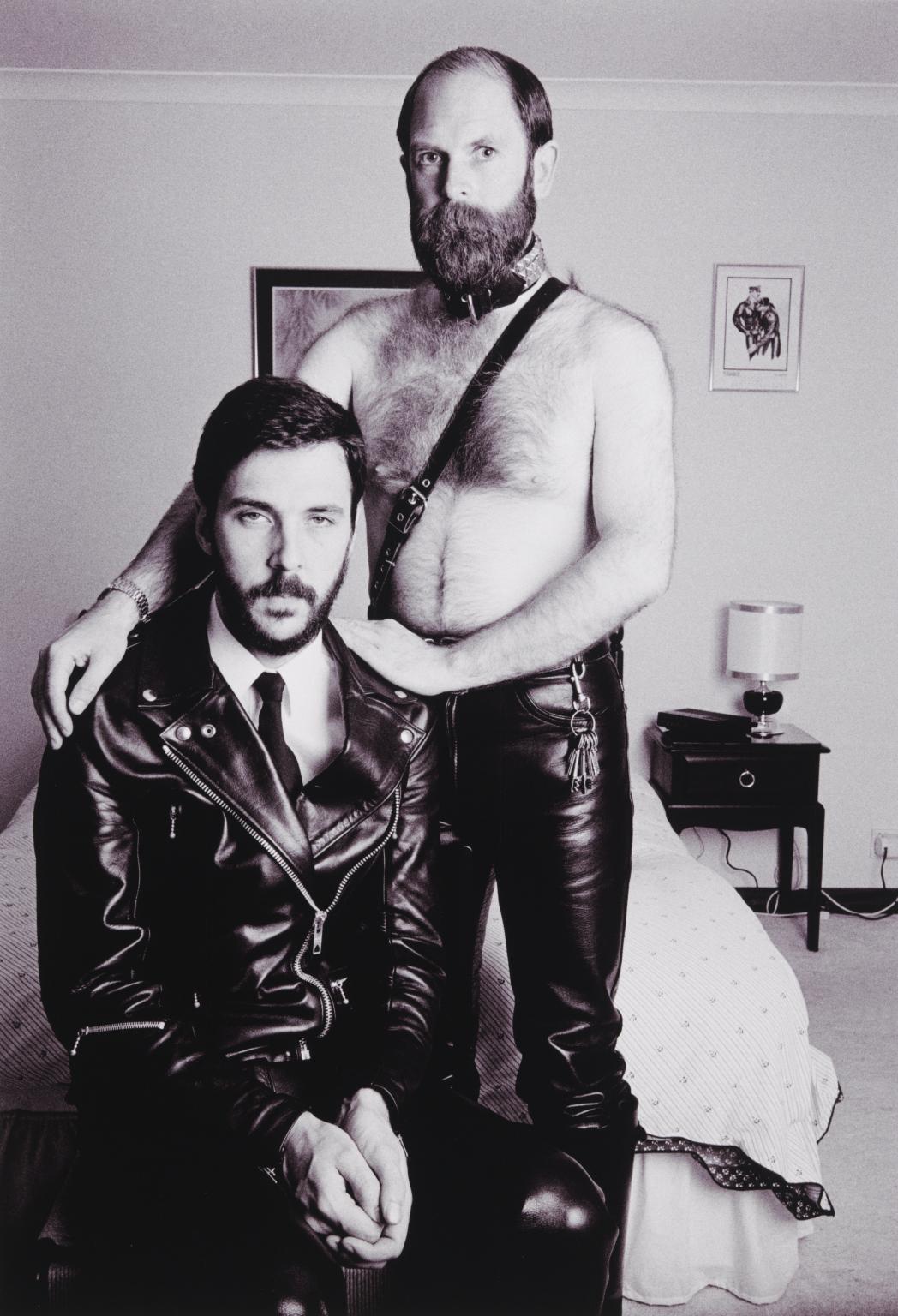
Sunil Gupta, Dylan & Gerald, London 1985, printed 2018
This series of black and white portraits features gay and lesbian couples from Sunil Guptaãs social circles in London and Newcastle. Called Lovers: Ten Years On, the project was shot over a period of two years from 1984ã6, following the end of Guptaãs own ten-year relationship. Reminiscent of traditional family portraits, the photographs show couples in affectionate poses in their own living spaces. Prejudicial coverage of the HIV and AIDS epidemic in the 1980s threatened to turn public opinion against the acceptance of queer relationships, which were portrayed as ãsexually deviantã. In contrast to these offensive depictions of queer love, the people in Lovers: Ten Years On are often presented as quite ordinary, middle-class, professional couples. Many of the people photographed would later lose their lives to HIV and AIDS.
Gallery label, January 2025
15/30
artworks in No Such Thing as Society
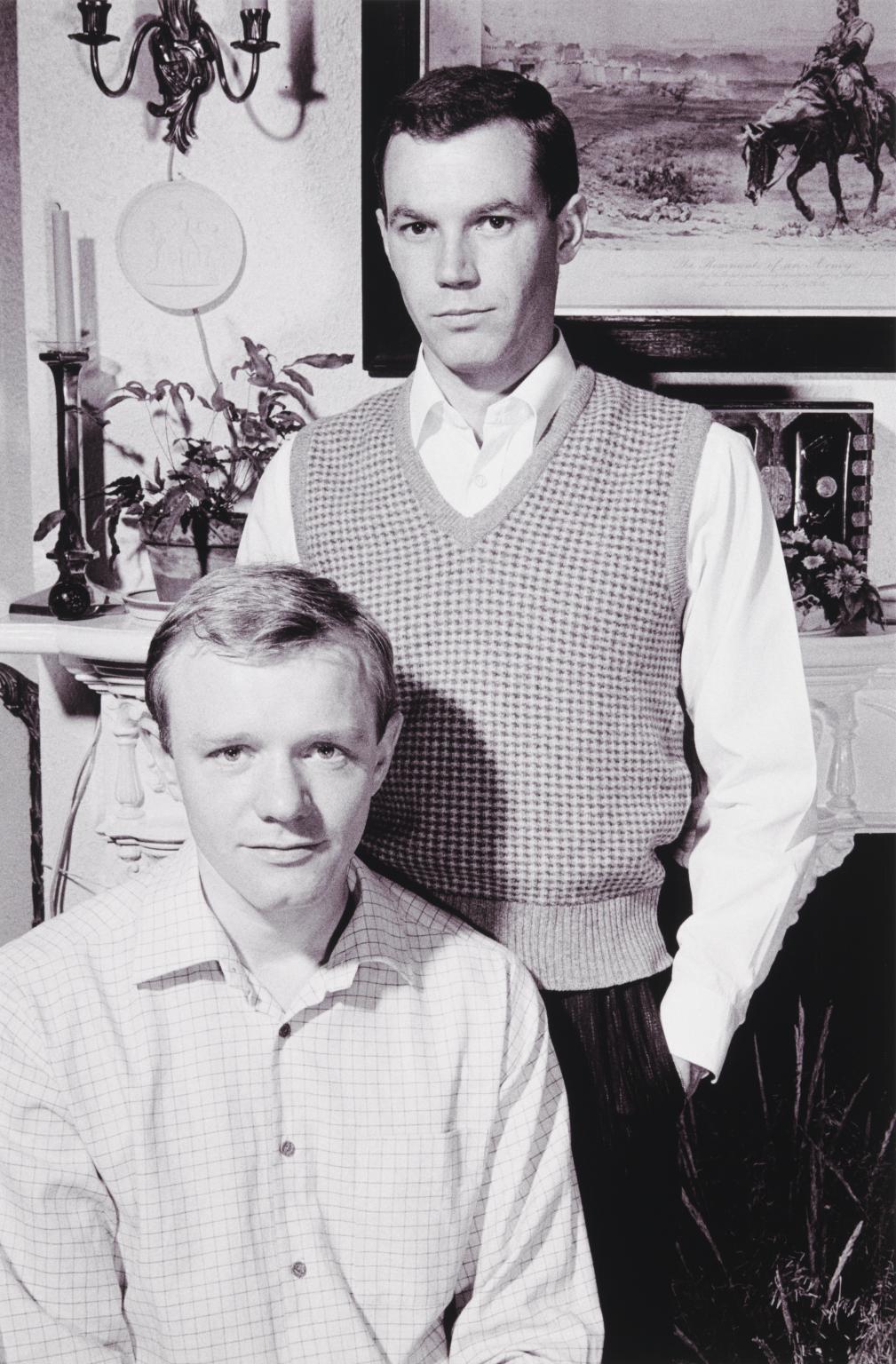
Sunil Gupta, Karl & Daniel, London 1985, printed 2018
This series of black and white portraits features gay and lesbian couples from Sunil Guptaãs social circles in London and Newcastle. Called Lovers: Ten Years On, the project was shot over a period of two years from 1984ã6, following the end of Guptaãs own ten-year relationship. Reminiscent of traditional family portraits, the photographs show couples in affectionate poses in their own living spaces. Prejudicial coverage of the HIV and AIDS epidemic in the 1980s threatened to turn public opinion against the acceptance of queer relationships, which were portrayed as ãsexually deviantã. In contrast to these offensive depictions of queer love, the people in Lovers: Ten Years On are often presented as quite ordinary, middle-class, professional couples. Many of the people photographed would later lose their lives to HIV and AIDS.
Gallery label, January 2025
16/30
artworks in No Such Thing as Society
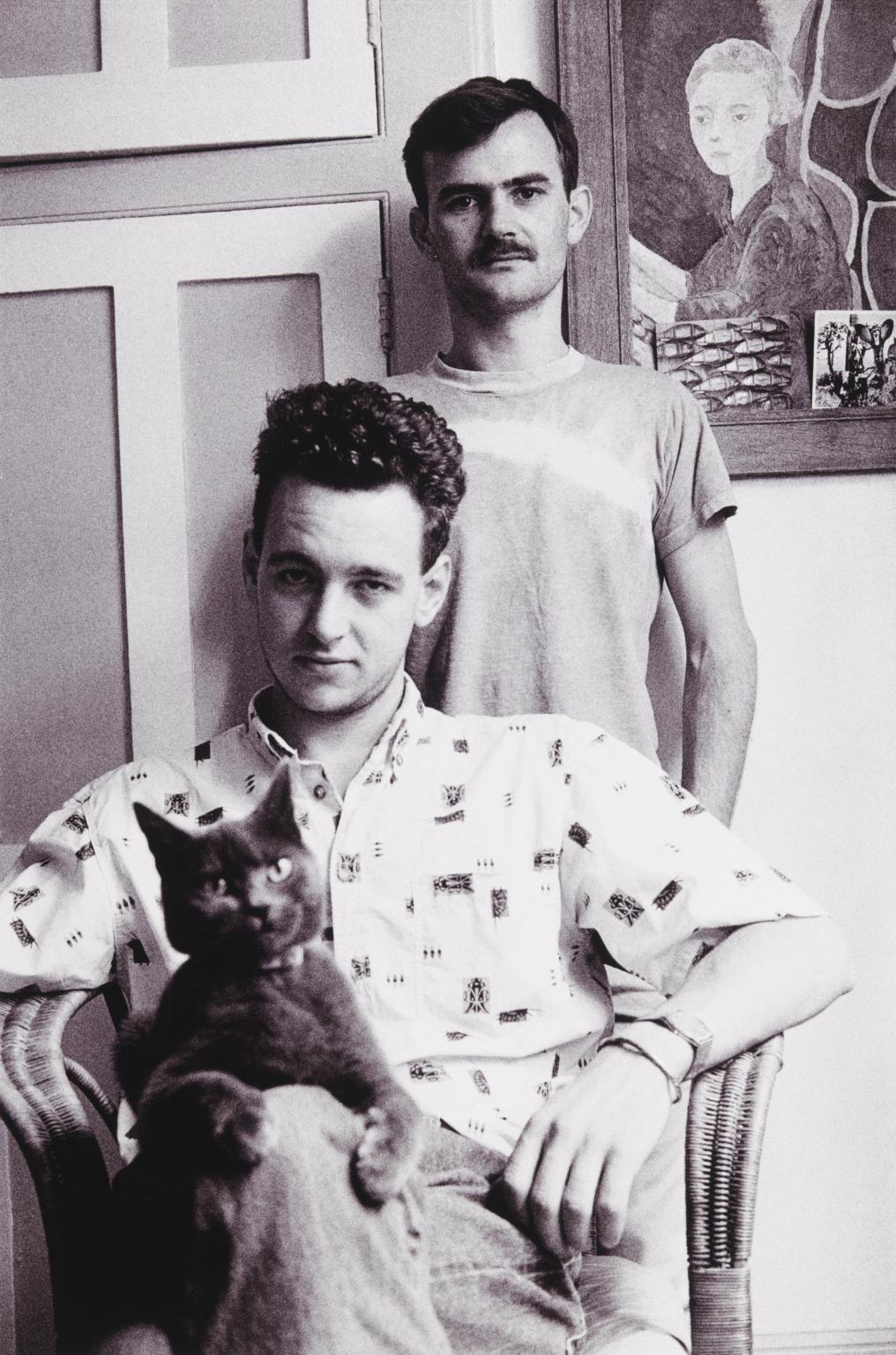
Sunil Gupta, Roger & Steve, London 1984, printed 2018
This series of black and white portraits features gay and lesbian couples from Sunil Guptaãs social circles in London and Newcastle. Called Lovers: Ten Years On, the project was shot over a period of two years from 1984ã6, following the end of Guptaãs own ten-year relationship. Reminiscent of traditional family portraits, the photographs show couples in affectionate poses in their own living spaces. Prejudicial coverage of the HIV and AIDS epidemic in the 1980s threatened to turn public opinion against the acceptance of queer relationships, which were portrayed as ãsexually deviantã. In contrast to these offensive depictions of queer love, the people in Lovers: Ten Years On are often presented as quite ordinary, middle-class, professional couples. Many of the people photographed would later lose their lives to HIV and AIDS.
Gallery label, January 2025
17/30
artworks in No Such Thing as Society
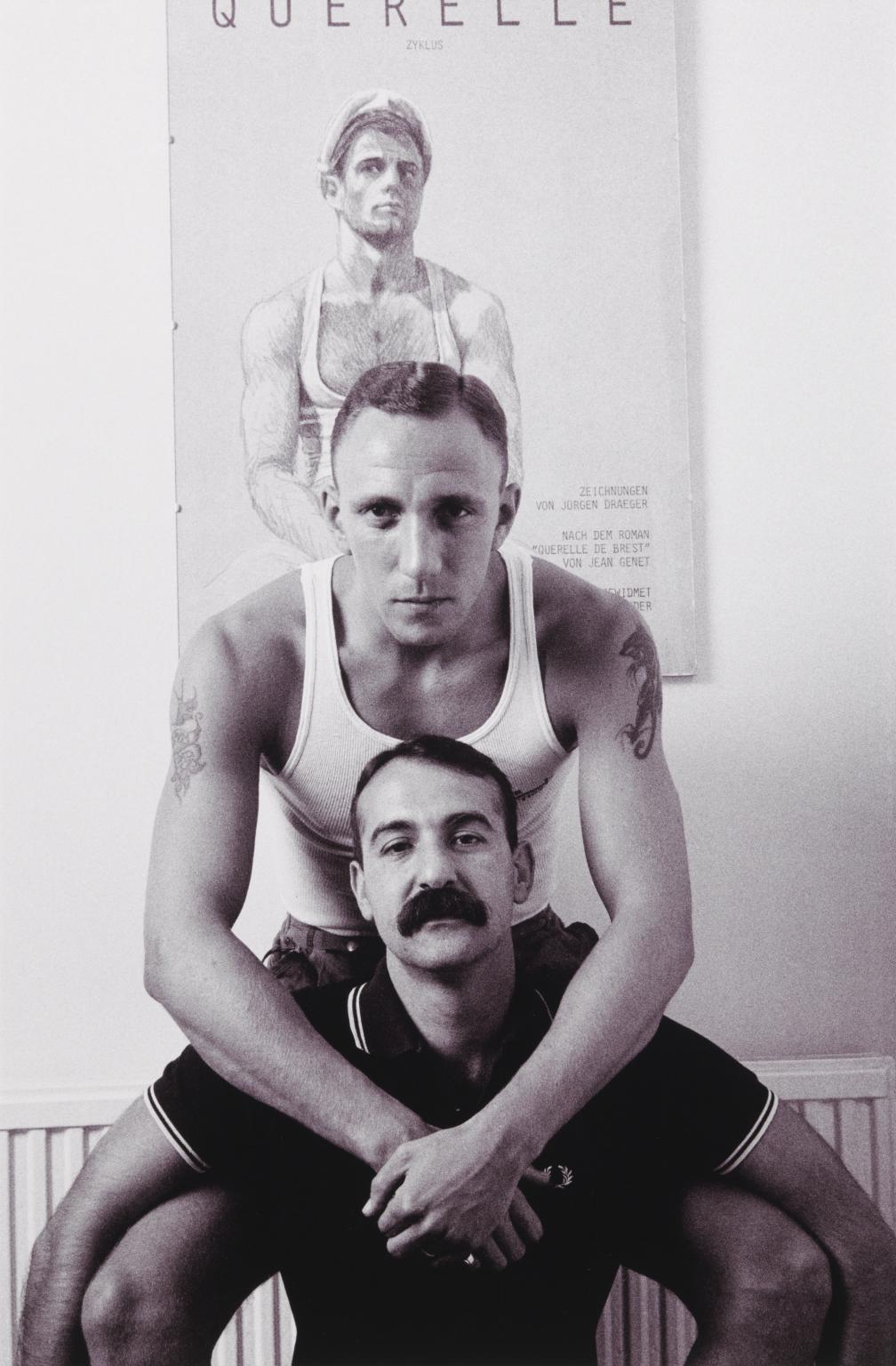
Sunil Gupta, Ian & Pavlik, London 1984, printed 2018
This series of black and white portraits features gay and lesbian couples from Sunil Guptaãs social circles in London and Newcastle. Called Lovers: Ten Years On, the project was shot over a period of two years from 1984ã6, following the end of Guptaãs own ten-year relationship. Reminiscent of traditional family portraits, the photographs show couples in affectionate poses in their own living spaces. Prejudicial coverage of the HIV and AIDS epidemic in the 1980s threatened to turn public opinion against the acceptance of queer relationships, which were portrayed as ãsexually deviantã. In contrast to these offensive depictions of queer love, the people in Lovers: Ten Years On are often presented as quite ordinary, middle-class, professional couples. Many of the people photographed would later lose their lives to HIV and AIDS.
Gallery label, January 2025
18/30
artworks in No Such Thing as Society
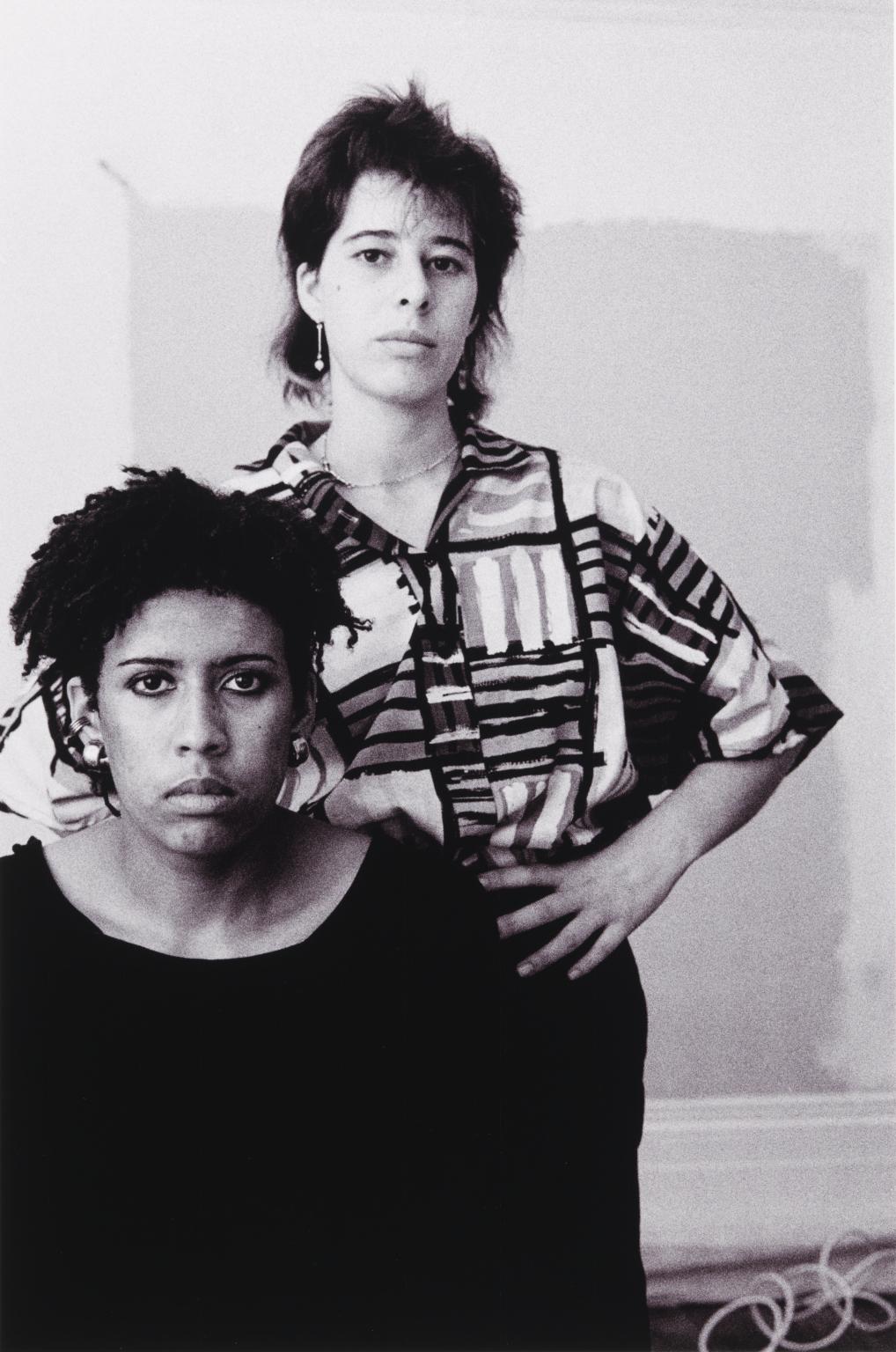
Sunil Gupta, Lisa & Emily, London 1984, printed 2018
This is one of a group of photographs in ¯íý¿°ìÝÞãs collection from Sunil Guptaãs Lovers: Ten Years On, a series of over thirty black and white portraits of gay couples taken in the United Kingdom between 1984 and 1986 (Tate P82123ãP82137 and Ian and Julian P13784). With the exception of Martin & Gary, Newcastle-upon-Tyne 1984 (Tate P82123), they were all taken in London. Lovers: Ten Years On was made after Guptaãs own ten-year relationship ended and, as a form of social analysis, he decided to document the long-term gay relationships he encountered and the changing sensibilities of the social environment he found himself a part of. Most of the subjects are from his own social milieu at the time, professional couples resident in the Greater London area. Taken over a period of two years, the black and white portraits all follow the same format ã they are shot in domestic interiors, the poses and arrangements reminiscent of traditional family photographs. The subjects are centred in the frame and look directly into the camera. Most of the couples are shown in affectionate poses and embraces within their domestic settings; some included their pets in the picture, others chose to be depicted in front of works of art in their living rooms, surrounded by books, or in their kitchens.The series was accompanied by an artistãs statement, in which Gupta observed that while there had been a shift in gay self-consciousness since the 1970s, the arrival of HIV and Aids had once again turned public opinion against the acceptance of homosexuality, and that its popular and commercial representations were dominated by a stereotype of deviance. In contrast, the couples in Lovers: Ten Years On are shown as often quite ordinary, white middle-class, professional people in long term monogamous relationships. Gupta wrote:
19/30
artworks in No Such Thing as Society
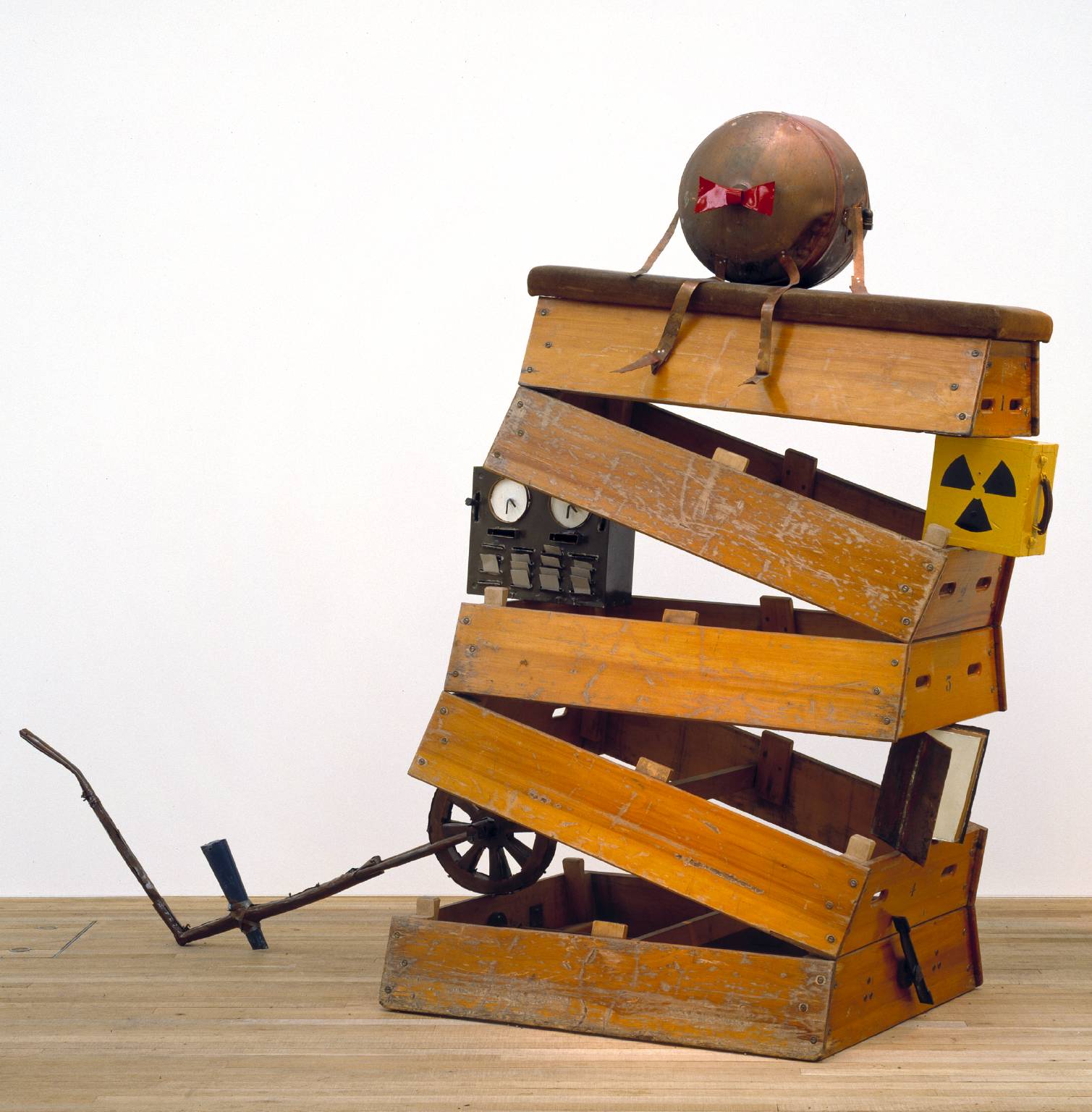
Bill Woodrow, English Heritage - Humpty Fucking Dumpty 1987
Wedged between the sections of a vaulting box are representations of a wheeled plough, a book, a clocking-in machine and a box with radiation hazard markings. This succession of objects symbolises human progress, creating what Woodrow calls 'a section through history'. At the top of the precarious structure sits the figure of Humpty Dumpty who, according to the nursery rhyme, 'sat on a wall' and 'had a great fall'. The ironic title English Heritage reflects Woodrow''s discomfort with the amount of jingoism in Britain during the 1980s, as well as a desire to question what actually constitutes his own heritage.
Gallery label, August 2004
20/30
artworks in No Such Thing as Society
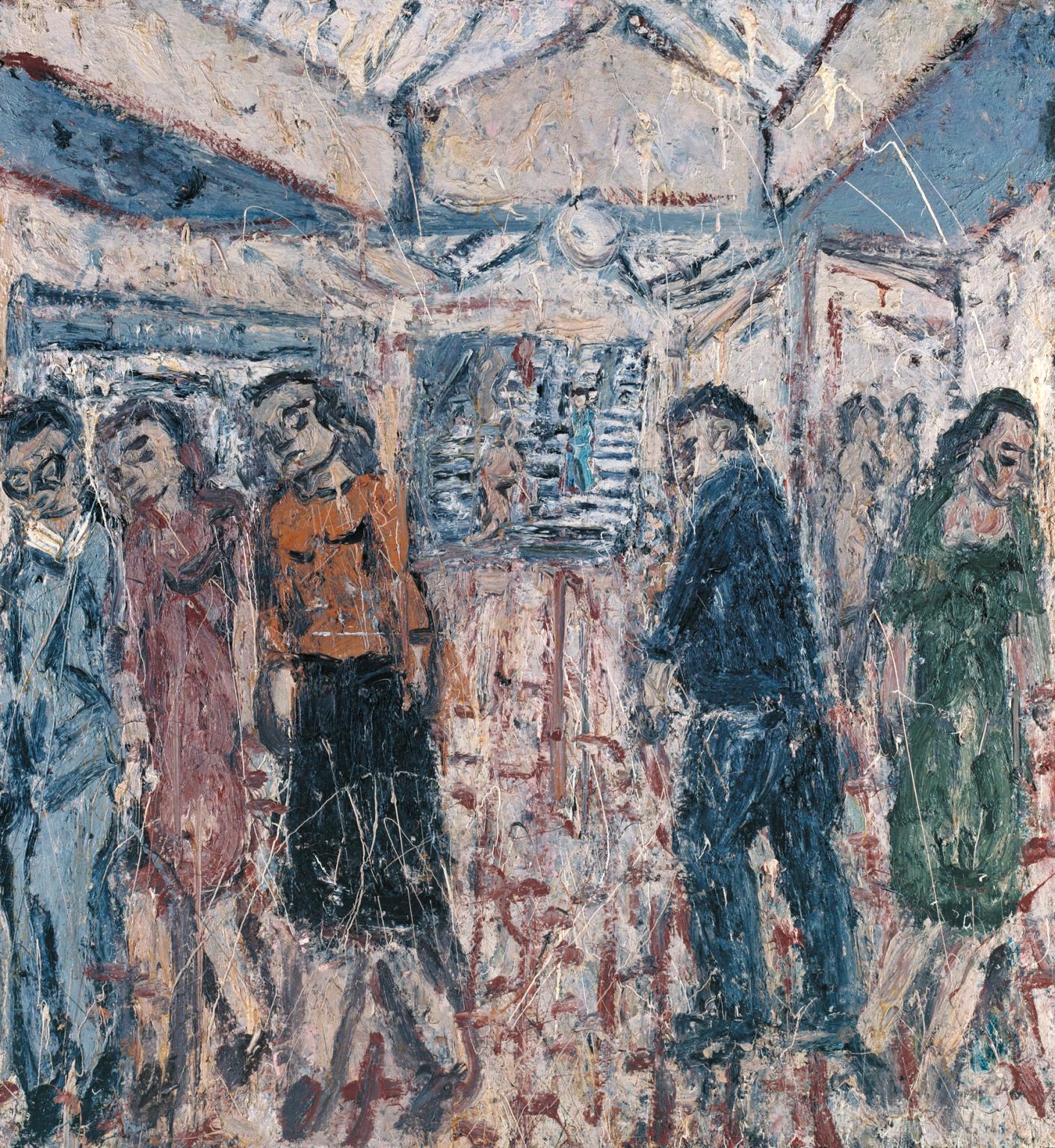
Leon Kossoff, Booking Hall, Kilburn Underground 1987
Kossoffãs principal subjects are his family and friends, and the parts of London best knownto him, and he reflected that, when painting public scenes, portraits of people close to him begin to appear within the crowd. This large painting belongs to a series depicting Kilburn Underground station in north London. Kossoff stated that ãthe shuddering feet of the sprawling city linger in my mind like a faintly glimmering memory of a long forgotten, perhaps never experienced childhood which, if rediscovered and illuminated, would ameliorate the pain of the present.ã
Gallery label, September 2016
21/30
artworks in No Such Thing as Society
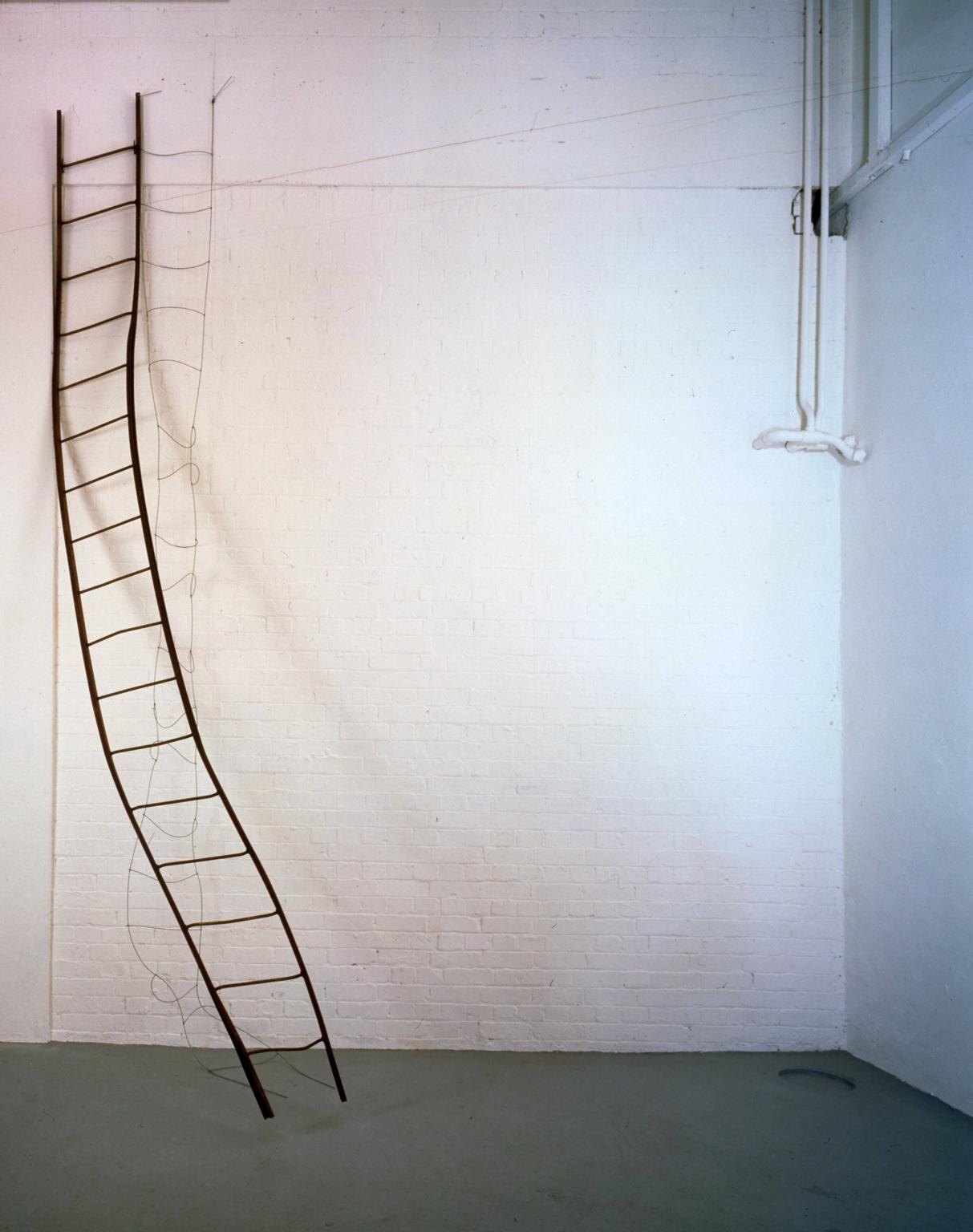
Richard Wentworth, 35ô¯9,32ô¯18 1985
This is a work which plays on tension and illusion. The tall steel ladder was retrieved from a scrap heap. The cable ladder looks as though it could be the shadow of the steel ladder, but its form is more wayward. The sculpture was made for an exhibition in Israel. The title is a map reference. The artist relates that he asked a student in Israel if one could locate the place of Jacob's dream as related in the Bible (Genesis 28,10). 'Oh yes he said, I'll have it for you tomorrow morning, and that gave the work its title; fable and military precision in one'. Jacob's dream was of a ladder from earth to heaven.
Gallery label, August 2004
22/30
artworks in No Such Thing as Society
Tish Murtha, Kids Jumping on to Mattresses from the series ãYouth Unemploymentã 1981
This black and white photograph is from Tish Murthaãs series Youth Unemployment 1981. Murtha studied documentary photography in Newport, Wales, where she was taught by photographer David Hurn (born 1934), a member of the international photography cooperative Magnum Photos. She returned to the Newcastle area in 1978, capturing the impact of deindustrialisation, as well as the social and economic disadvantages of those living in her area, disadvantages which she had also experienced.
23/30
artworks in No Such Thing as Society
Tish Murtha, Lads with ãOld Dearsã on Bench from the series ãYouth Unemploymentã 1981
This black and white photograph is from Tish Murthaãs series Youth Unemployment 1981. Murtha studied documentary photography in Newport, Wales, where she was taught by photographer David Hurn (born 1934), a member of the international photography cooperative Magnum Photos. She returned to the Newcastle area in 1978, capturing the impact of deindustrialisation, as well as the social and economic disadvantages of those living in her area, disadvantages which she had also experienced.
24/30
artworks in No Such Thing as Society
Tish Murtha, SuperMac from the series ãElswick Kidsã 1978
This black and white photograph is from Tish Murthaãs series Elswick Kids 1978. Murtha studied documentary photography in Newport, Wales, where she was taught by photographer David Hurn (born 1934), a member of the international photography cooperative Magnum Photos. She returned to the Newcastle area in 1978, capturing the impact of deindustrialisation, as well as the social and economic disadvantages of those living in her area, disadvantages which she had also experienced.
25/30
artworks in No Such Thing as Society
Tish Murtha, Kenilworth Road Kids, Cruddas Park from the series ãJuvenile Jazz Bandsã 1979
This black and white photograph is from Tish Murthaãs series Juvenile Jazz Bands 1979. Murtha studied documentary photography in Newport, Wales, where she was taught by photographer David Hurn (born 1934), a member of the international photography cooperative Magnum Photos. She returned to the Newcastle area in 1978, capturing the impact of deindustrialisation, as well as the social and economic disadvantages of those living in her area, disadvantages which she had also experienced.
26/30
artworks in No Such Thing as Society
Tish Murtha, Noble Street from the series ãJuvenile Jazz Bandsã 1979
This black and white photograph is from Tish Murthaãs series Juvenile Jazz Bands 1979. Murtha studied documentary photography in Newport, Wales, where she was taught by photographer David Hurn (born 1934), a member of the international photography cooperative Magnum Photos. She returned to the Newcastle area in 1978, capturing the impact of deindustrialisation, as well as the social and economic disadvantages of those living in her area, disadvantages which she had also experienced.
27/30
artworks in No Such Thing as Society
Tish Murtha, Jarrow Carnival from the series ãJuvenile Jazz Bandsã 1979
This black and white photograph is from Tish Murthaãs series Juvenile Jazz Bands 1979. Murtha studied documentary photography in Newport, Wales, where she was taught by photographer David Hurn (born 1934), a member of the international photography cooperative Magnum Photos. She returned to the Newcastle area in 1978, capturing the impact of deindustrialisation, as well as the social and economic disadvantages of those living in her area, disadvantages which she had also experienced.
28/30
artworks in No Such Thing as Society
Tish Murtha, Judging Binchester from the series ãJuvenile Jazz Bandsã 1979
This black and white photograph is from Tish Murthaãs series Juvenile Jazz Bands 1979. Murtha studied documentary photography in Newport, Wales, where she was taught by photographer David Hurn (born 1934), a member of the international photography cooperative Magnum Photos. She returned to the Newcastle area in 1978, capturing the impact of deindustrialisation, as well as the social and economic disadvantages of those living in her area, disadvantages which she had also experienced.
29/30
artworks in No Such Thing as Society
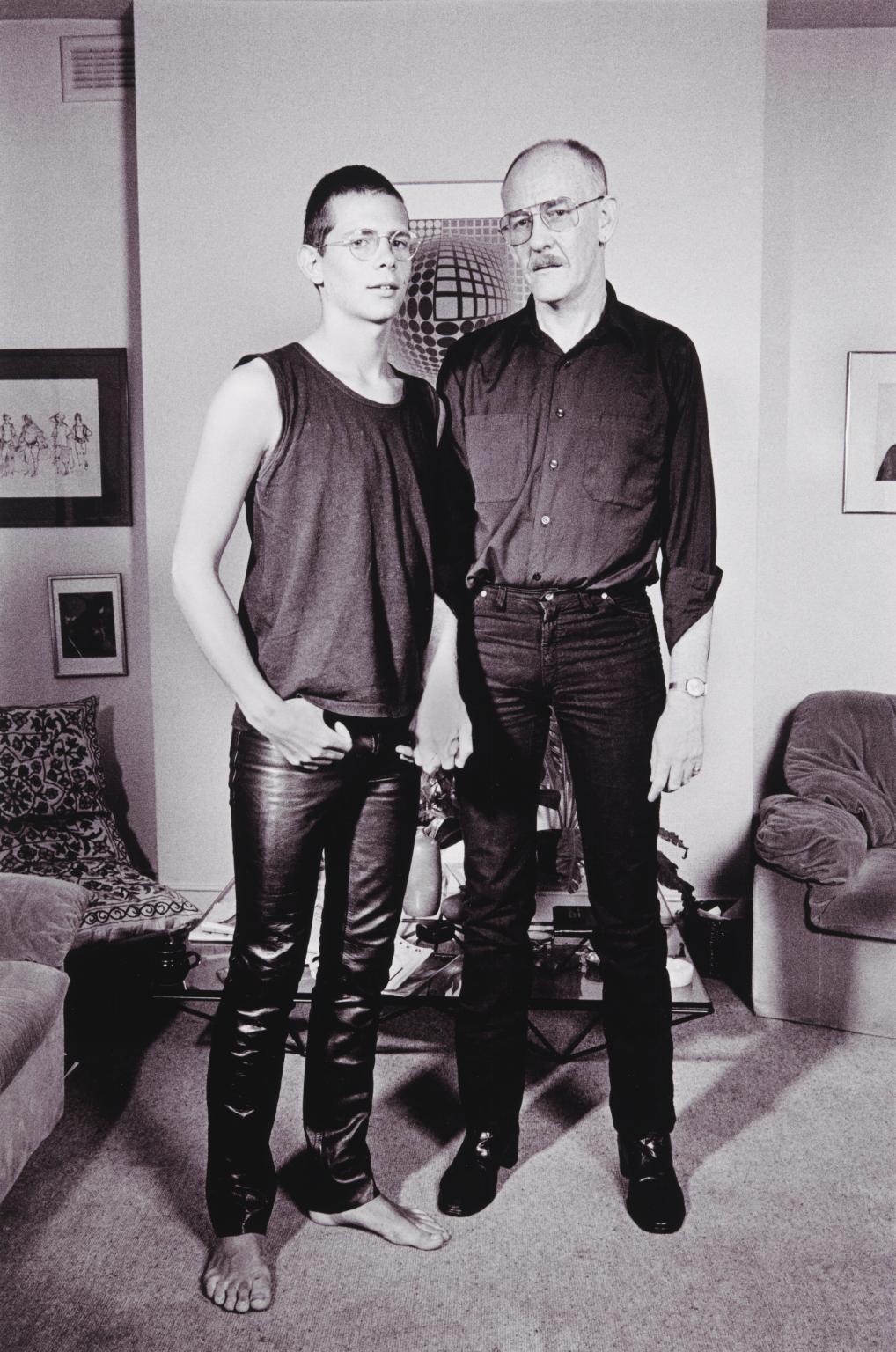
Sunil Gupta, Andrew & John, London 1985, printed 2018
This series of black and white portraits features gay and lesbian couples from Sunil Guptaãs social circles in London and Newcastle. Called Lovers: Ten Years On, the project was shot over a period of two years from 1984ã6, following the end of Guptaãs own ten-year relationship. Reminiscent of traditional family portraits, the photographs show couples in affectionate poses in their own living spaces. Prejudicial coverage of the HIV and AIDS epidemic in the 1980s threatened to turn public opinion against the acceptance of queer relationships, which were portrayed as ãsexually deviantã. In contrast to these offensive depictions of queer love, the people in Lovers: Ten Years On are often presented as quite ordinary, middle-class, professional couples. Many of the people photographed would later lose their lives to HIV and AIDS.
Gallery label, January 2025
30/30
artworks in No Such Thing as Society
Art in this room
Sorry, no image available





















Sorry, no image available
Sorry, no image available
Sorry, no image available
Sorry, no image available
Sorry, no image available
Sorry, no image available
Sorry, no image available

You've viewed 6/30 artworks
You've viewed 30/30 artworks
